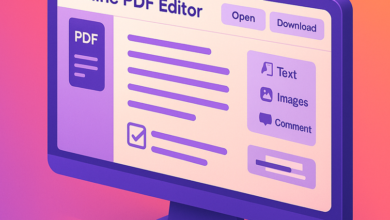How to Design an Effective Onboarding Process for Your Mobile App

Creating an engaging and efficient onboarding process for your mobile app is crucial to converting new users into long-term customers. First impressions matter, and the onboarding experience often determines whether a user will continue to engage with your app or abandon it after a few uses. A smooth, intuitive onboarding experience can boost user retention, increase engagement, and reduce churn.
A well-designed onboarding process not only explains the features and value of the app but also helps users feel comfortable and confident using it. One innovative strategy that many app developers and marketers use is the nudge approach, which involves subtly guiding users toward desired behaviors without being intrusive. This strategy can enhance the onboarding process and ultimately lead to a more successful app experience.
In this blog, we’ll explore how to design an effective onboarding process, and how implementing smart nudges can elevate the user experience and ensure long-term engagement with your mobile app.
Why Onboarding Matters for Your Mobile App
Onboarding is the first opportunity you have to introduce users to your app. It’s more than just a series of screens—it’s your chance to highlight the app’s core value proposition, walk users through key features, and build trust. If done right, onboarding can dramatically reduce churn and boost user retention.
According to research, a good onboarding experience can increase user retention by up to 50% in the first 30 days. On the other hand, a poor onboarding experience can result in users abandoning the app before they even get a chance to experience its value.
By offering a clear, easy-to-follow onboarding process, you’re setting users up for success, making them feel confident in their ability to use the app, and, most importantly, showing them how the app will improve their daily lives.
Key Principles for Designing a Great Onboarding Process
The goal of your app’s onboarding process is simple: guide users toward understanding how to use the app, how to derive value from it, and how to incorporate it into their daily routine. But the execution of this goal involves several critical steps.
a. Keep it Short and Sweet
Nobody wants to wade through long tutorials or sign-up forms. Your onboarding process should be brief, yet informative enough to ensure users understand what the app does. Too much information upfront can overwhelm users, so focus on the most essential features during onboarding.
A good rule of thumb is to limit onboarding to just 3-5 steps that help users quickly get familiar with your app. If you have a complex app with multiple features, consider breaking up the onboarding into stages so users can explore features as they need them.
b. Emphasize the Value Proposition
Don’t just show users how to use your app; focus on explaining why they should use it. Users need to see the value from the get-go, so emphasize the benefits they will get from your app right in the onboarding process.
For instance, if your app helps users save time, highlight that in your messaging. If it provides convenience, explain how users will experience a smoother day-to-day life by using your app. The clearer you make the value proposition, the more likely users will stick around.
c. Personalization is Key
Today’s users expect personalized experiences, so try to make the onboarding experience feel tailored to their needs. Consider asking for minimal information, such as their name or preferences, early on in the process. By doing this, you can customize the app experience based on their input.
For example, if you’re building a fitness app, ask users for their fitness goals during onboarding so you can provide them with personalized workout recommendations. Personalized onboarding creates a deeper connection with your users, making them feel valued from the start.
d. Use Interactive and Visual Elements
People remember visual information much better than text, so use images, videos, and interactive tutorials to explain how your app works. Incorporate animations, short videos, and visually appealing walkthroughs to keep users engaged.
Interactive elements allow users to get a hands-on feel of the app and help them understand how to use it in real-time. Gamifying the onboarding process or giving users immediate tasks to complete can also enhance engagement.
e. Provide Clear Navigation
Your onboarding process should have a clear flow from step to step. Ensure users always know where they are in the process and how many steps remain. Adding progress bars, simple navigation buttons, and “Next” indicators makes the experience more intuitive and user-friendly.
f. Make It Skippable
Some users may want to dive straight into the app without going through the onboarding process. Always give users the option to skip or fast-forward through the onboarding, but make sure you provide them with an easy way to return to it later. Forcing users through lengthy tutorials could lead to frustration and app abandonment.
How Nudges Can Improve Your Onboarding Process
Nudges are subtle, non-intrusive suggestions that encourage users to take specific actions. They are a powerful tool in improving the user experience during onboarding, as they gently guide users toward completing desired behaviors without being forceful.
For example, when you encourage users to fill in their profile information or complete a task, using a nudge can make these actions seem effortless. Nudging users toward specific actions during onboarding increases the likelihood of successful user engagement and enhances the long-term retention of the app.
Here’s how you can implement nudges to improve your onboarding process:
a. Progress Indicators
Showing users their progress during the onboarding process can be a powerful nudge. Progress bars or a step-by-step checklist give users a sense of accomplishment and motivate them to complete the process. For example, a simple indicator like “You’re 60% of the way there” makes users feel closer to finishing and more likely to follow through.
b. Personalized Notifications
If users skip steps during onboarding (like completing their profile), you can nudge them back to these actions later. For example, sending personalized notifications or reminders that say, “Your profile isn’t complete! Add a photo to get more relevant recommendations” can encourage users to take action without being overbearing.
c. Gamification
Gamification elements, like earning badges or points, can serve as nudges that encourage users to complete tasks within the onboarding process. For example, offering a “Completion Badge” when users finish all onboarding steps gives them a sense of accomplishment, nudging them to continue using the app
A/B Testing: Optimizing Your Onboarding Process
Onboarding isn’t a one-size-fits-all process, and it’s important to test different approaches to see what works best for your audience. A/B testing allows you to test different versions of the onboarding process, so you can identify the features, flow, and messaging that resonate most with users.
You might test variations such as:
- Length of onboarding: Does a shorter or longer process lead to better retention?
- Type of nudge: Does progress tracking or gamification have a greater impact on user retention?
- Visual elements: Are animations more effective than static images?
By continually optimizing your onboarding process, you can create the best possible experience for your users and increase the likelihood of long-term app engagement.
Conclusion
An effective onboarding process is essential for any mobile app looking to thrive in today’s competitive market. The goal is to make new users feel comfortable, confident, and motivated to use the app regularly. By keeping the process short and sweet, emphasizing your app’s value, offering personalization, and integrating nudges to guide users, you can create an onboarding experience that converts users into loyal, engaged customers.
Remember, the onboarding process doesn’t end after the first few screens—it’s an ongoing opportunity to build a lasting relationship with your users. As the market evolves, so too should your onboarding process, always keeping in mind the needs and preferences of your users.
So, whether you’re creating a brand-new mobile app or looking to improve an existing one, using nudges and other smart strategies can set your app up for success and ensure your users stick around for the long haul.




